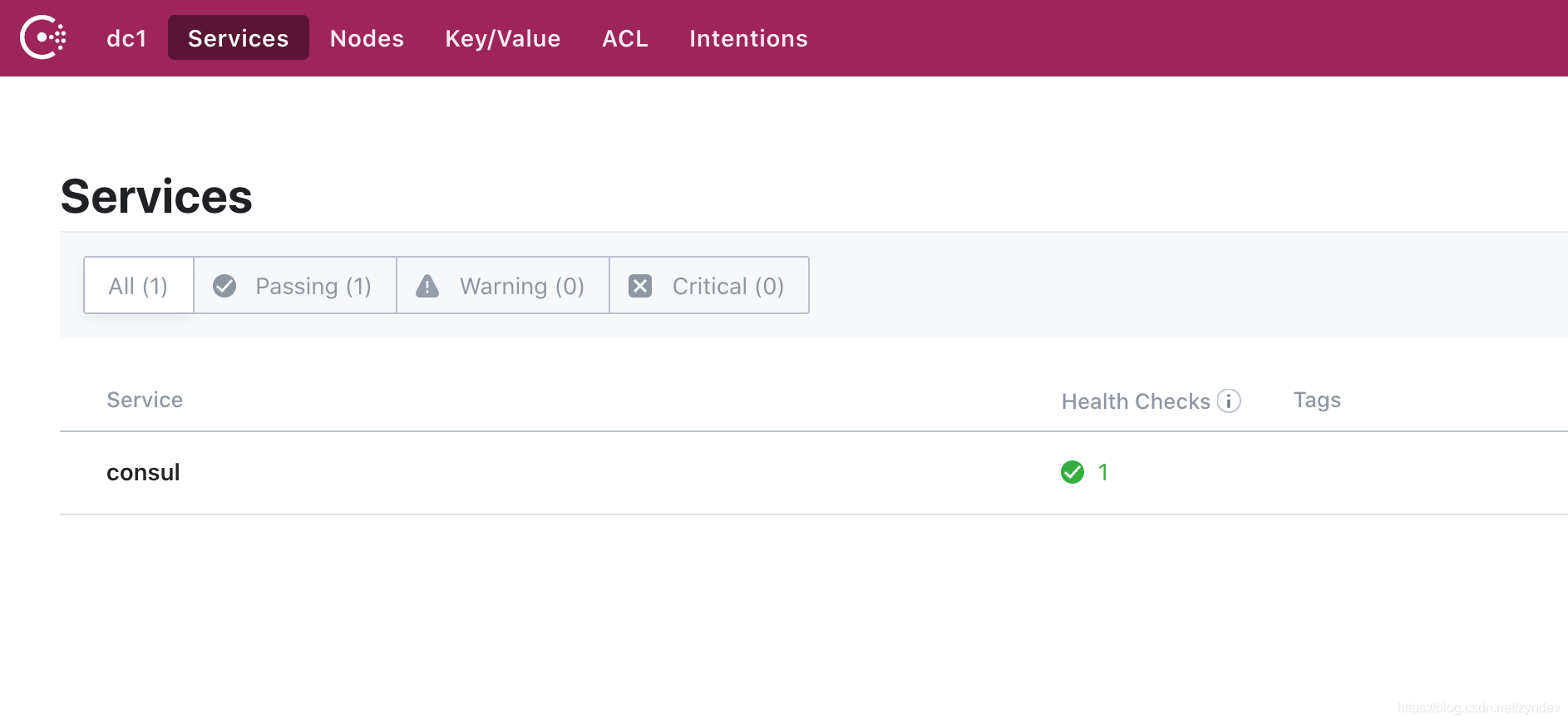Python 使用 consul 做服務(wù)發(fā)現(xiàn)示例詳解
前面一章講了微服務(wù)的一些優(yōu)點(diǎn)和缺點(diǎn),那如何做到
一、目標(biāo)二、使用步驟1. 安裝 consul我們可以直接使用官方提供的二進(jìn)制文件來(lái)進(jìn)行安裝部署,其官網(wǎng)地址為 https://www.consul.io/downloads

下載后為可執(zhí)行文件,在我們開(kāi)發(fā)試驗(yàn)過(guò)程中,可以直接使用 consul agent -dev 命令來(lái)啟動(dòng)一個(gè)單節(jié)點(diǎn)的 consul
在啟動(dòng)的打印日志中可以看到 agent: Started HTTP server on 127.0.0.1:8500 (tcp), 我們可以在瀏覽器直接訪問(wèn) 127.0.0.1:8500 即可看到如下

這里我們的 consul 就啟動(dòng)成功了
2. 服務(wù)注冊(cè)在網(wǎng)絡(luò)編程中,一般會(huì)提供項(xiàng)目的 IP、PORT、PROTOCOL,在服務(wù)治理中,我們還需要知道對(duì)應(yīng)的服務(wù)名、實(shí)例名以及一些自定義的擴(kuò)展信息
在這里使用 ServiceInstance 接口來(lái)規(guī)定注冊(cè)服務(wù)時(shí)必須的一些信息
class ServiceInstance: def __init__(self, service_id: str, host: str, port: int, secure: bool = False, metadata: dict = None, instance_id: str = None): self.service_id = service_id self.host = host self.port = port self.secure = secure self.metadata = metadata self.instance_id = instance_id def get_instance_id(self): return
定義基類(lèi)
在上面規(guī)定了需要注冊(cè)的服務(wù)的必要信息,下面定義下服務(wù)注冊(cè)和剔除的方法,方便以后實(shí)現(xiàn) Eureka 和 Redis 的方式
import abcclass ServiceRegistry(abc.ABC): @abc.abstractmethod def register(self, service_instance: ServiceInstance): pass @abc.abstractmethod def deregister(self): pass
具體實(shí)現(xiàn)
因?yàn)?consul 提供了 http 接口來(lái)對(duì)consul 進(jìn)行操作,我們也可以使用 http 請(qǐng)求方式進(jìn)行注冊(cè)和剔除操作,具體 http 接口文檔見(jiàn) https://www.consul.io/api-docs, consul 并沒(méi)有提供 Python 語(yǔ)言的實(shí)現(xiàn),這里使用 python-consul 來(lái)訪問(wèn) consul
import consulclass ConsulServiceRegistry(ServiceRegistry): _consul = None _instance_id = None def __init__(self, host: str, port: int, token: str = None): self.host = host self.port = port self.token = token self._consul = consul.Consul(host, port, token=token) def register(self, service_instance: ServiceInstance): schema = 'http' if service_instance.secure: schema = 'https' check = consul.Check.http(f’{schema}:{service_instance.host}:{service_instance.port}/actuator/health’, '1s', '3s', '10s') self._consul.agent.service.register(service_instance.service_id, service_id=service_instance.instance_id, address=service_instance.host, port=service_instance.port, check=check) self._instance_id = service_instance.instance_id def deregister(self): if self._instance_id: self._consul.agent.service.deregister(service_id=self._instance_id) self._instance_id = None3. 服務(wù)發(fā)現(xiàn)
在服務(wù)發(fā)現(xiàn)中,一般會(huì)需要兩個(gè)方法
獲取所有的服務(wù)列表 獲取指定的服務(wù)的所有實(shí)例信息基類(lèi)定義
import abcclass DiscoveryClient(abc.ABC): @abc.abstractmethod def get_services(self) -> list: pass @abc.abstractmethod def get_instances(self, service_id: str) -> list: pass
具體實(shí)現(xiàn)
來(lái)實(shí)現(xiàn)一下
這里是簡(jiǎn)化版,所以一些參數(shù)直接寫(xiě)死了,如果需要可以適當(dāng)修改
import consulclass ConsulServiceDiscovery(DiscoveryClient): _consul = None def __init__(self, host: str, port: int, token: str = None): self.host = host self.port = port self.token = token self._consul = consul.Consul(host, port, token=token) def get_services(self) -> list: return self._consul.catalog.services()[1].keys() def get_instances(self, service_id: str) -> list: origin_instances = self._consul.catalog.service(service_id)[1] result = [] for oi in origin_instances: result.append(ServiceInstance( oi.get(’ServiceName’), oi.get(’ServiceAddress’), oi.get(’ServicePort’), oi.get(’ServiceTags’), oi.get(’ServiceMeta’), oi.get(’ServiceID’), )) return result4. 測(cè)試用例
import unittestfrom random import randomclass MyTestCase(unittest.TestCase): def test_consul_register(self): instance = ServiceInstance('abc', '127.0.0.1', 8000, instance_id=f’abc_{random()}’) registry = ConsulServiceRegistry('127.0.0.1', 8500) discovery = ConsulServiceDiscovery('127.0.0.1', 8500) registry.register(instance) print(discovery.get_services()) print(discovery.get_instances('abc')) self.assertEqual(True, True)if __name__ == ’__main__’: unittest.main()總結(jié)
通過(guò)使用 consul api 我們可以簡(jiǎn)單的實(shí)現(xiàn)基于 consul 的服務(wù)發(fā)現(xiàn),在通過(guò)結(jié)合 http rpc 就可簡(jiǎn)單的實(shí)現(xiàn)服務(wù)的調(diào)用,下面一章來(lái)簡(jiǎn)單講下 go 如何發(fā)起 http 請(qǐng)求,為我們做 rpc 做個(gè)鋪墊
具體代碼見(jiàn) https://github.com/zhangyunan1994/gimini
參考
https://www.consul.io/api-docs
https://github.com/hashicorp/consul/tree/master/api
到此這篇關(guān)于Python 使用 consul 做服務(wù)發(fā)現(xiàn)的文章就介紹到這了,更多相關(guān)Python 使用 consul 服務(wù)內(nèi)容請(qǐng)搜索好吧啦網(wǎng)以前的文章或繼續(xù)瀏覽下面的相關(guān)文章希望大家以后多多支持好吧啦網(wǎng)!
相關(guān)文章:
1. moment轉(zhuǎn)化時(shí)間戳出現(xiàn)Invalid Date的問(wèn)題及解決2. python爬蟲(chóng)實(shí)戰(zhàn)之制作屬于自己的一個(gè)IP代理模塊3. 如何在jsp界面中插入圖片4. 詳解盒子端CSS動(dòng)畫(huà)性能提升5. HTML 絕對(duì)路徑與相對(duì)路徑概念詳細(xì)6. asp批量添加修改刪除操作示例代碼7. .NET6打包部署到Windows Service的全過(guò)程8. Ajax返回值類(lèi)型與用法實(shí)例分析9. 解決ajax請(qǐng)求后臺(tái),有時(shí)收不到返回值的問(wèn)題10. ajax請(qǐng)求后臺(tái)得到j(luò)son數(shù)據(jù)后動(dòng)態(tài)生成樹(shù)形下拉框的方法

 網(wǎng)公網(wǎng)安備
網(wǎng)公網(wǎng)安備